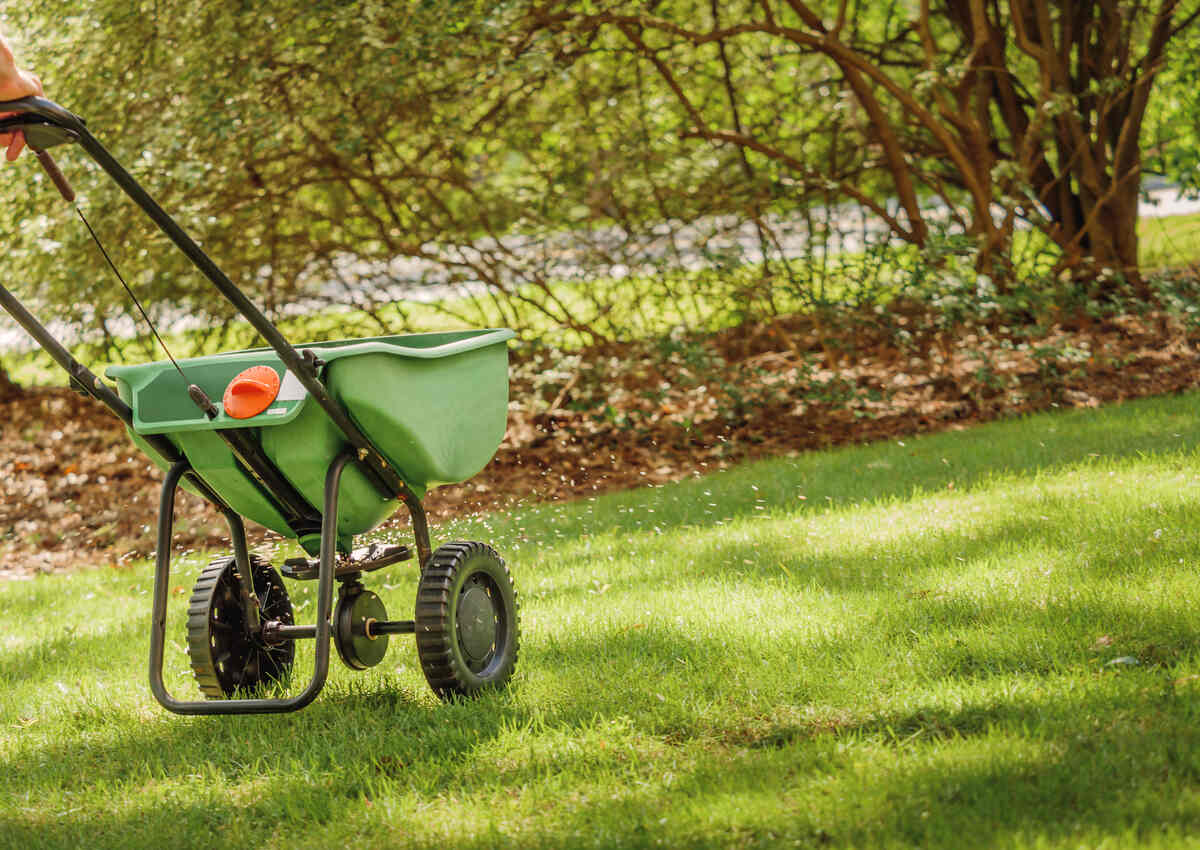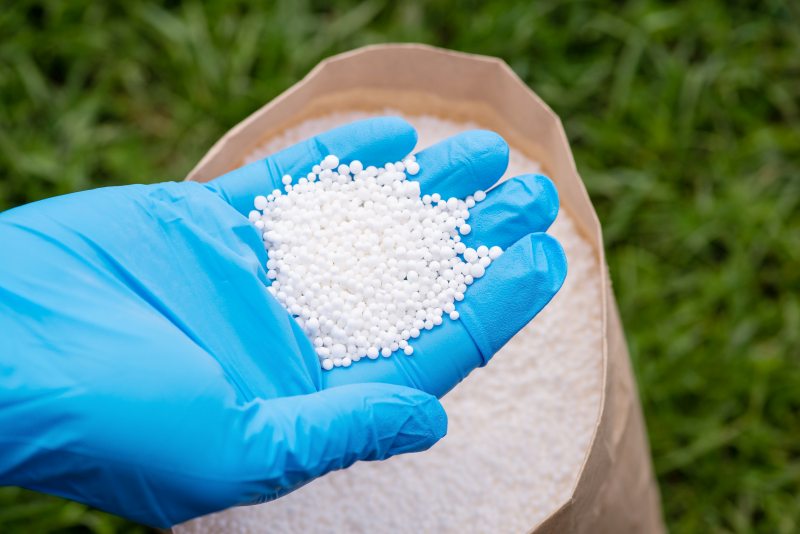
Fertilize your Colorado lawn according to its grass type: cool-season grasses like Kentucky bluegrass need a fall feeding (October to November). Warm-season grasses, including bermudagrass or buffalograss, thrive with fertilization in late spring to early summer (June or July).
Note that Colorado’s unique climates and high altitudes may require a few tweaks to your lawn care routine. For Colorado’s Rocky Mountains areas, consider fertilizing your lawn in early fall (mid-August to early September) instead of late fall. Also, if your grass needs a boost after winter, some spring fertilizer can help – just don’t go overboard. Always test your soil before starting.
If you’re new to lawn care and need to learn the basics, like how to fertilize and which products to use, check out our master guides:
Best Time to Fertilize Your Colorado Lawn
Colorado’s climate varies significantly across the state, from high plains to the mountain regions. This diversity significantly influences when and what type of grass you should plant, which in turn affects your fertilization schedule.
*Note: In Centennial State, you’ll mostly find cool-season grasses, but in warmer and drier areas, like around the Denver metro area and Eastern Plains, warm-season grasses, such as bermudagrass or buffalograss, also grow well.
Therefore, understanding what type of grass is present in your lawn is the first step to planning when to fertilize.
According to Colorado State University Extension, a typical fertilization timeline for established Colorado lawns is as follows:
| Timing | Cool-Season Grasses (Kentucky bluegrass, Perennial ryegrass, and fescues) | Warm-Season Grasses (Buffalograss; Blue gramma; Bermudagrass) |
| Mid-March to Early April | Optional low rate N application (if not fertilized the previous fall or if soil test indicates nitrogen is needed) | No fertilization |
| May to Mid-June | Second application (only if necessary) | First application (only if necessary |
| July to Early August | No fertilization | Main fertilization of the year |
| Mid-August to Mid-September | Main application only for high altitude areas | No fertilization |
| Early October to Early November | Main application for lower altitude areas (while the grass is still green) | No fertilization |
Based on the above time periods, you can figure out the best time to feed your grass, considering the following factors:
- Soil type
- Grass type
- Your region
- Local weather forecasts
- The general condition of your lawn
Key Point to Note: Always start with a soil test before applying any fertilizer. It’ll show you your lawn’s nitrogen, phosphorus, and potassium (N-P-K) levels and pH balance, helping you avoid excessive applications and promoting a healthy lawn.
Fertilization Schedule for Cool-Season Grasses in Colorado

Cool-season grasses in Colorado include Kentucky bluegrass, perennial ryegrass, and fescues.
These grass types thrive during the cooler season of spring and fall, with peak growth occurring in late spring and early fall. Based on this, your feeding schedule should ideally follow the growth pattern of these grasses.
Remember that lawn care experts recommend up to two to three applications per year for an established cool-season lawn in Colorado.
Here’s a general outline:
Early Spring (Mid-March to April)
If you followed the right fertilization schedule the previous year and properly returned clippings to the lawn, Colorado lawns typically shouldn’t require fertilizer in the early spring.
However, if you notice any areas of your lawn struggling to turn green in the spring, a light application may help:
- Apply about 0.5 pounds of nitrogen per 1,000 square feet for low-maintenance lawns, followed by another half-pound four to six weeks later, if necessary.
- For high-maintenance bluegrass lawns, you may increase this to 1 pound of nitrogen per 1,000 square feet.
*Note: For cool-season grasses, wait until they wake up from winter, usually when soil is above 50 degrees Fahrenheit, before applying.
Late Spring/Early Summer Fertilization (May – Mid June)
During May to mid-June, your cool grass season grass is still going strong, but the summer heat hasn’t hit. If you didn’t need to fertilize earlier in the spring (March-April) because your lawn was looking good, now’s a great time to give it some extra nutrients.
A little food for your lawn around May to mid-June can help it hold up against the summer heat.
But remember, only fertilize if your lawn needs it. Look for signs like slow growth or yellow color. If your grass looks healthy, you can wait until fall for the main fertilization.
If you haven’t already, test your soil to ensure it needs fertilizer.
- Apply 0.5 to 1 pound of nitrogen per 1,000 square feet, depending on your lawn’s health and grass type.
*Note: Avoid high-nitrogen fertilizers in summer, as they can cause excessive growth and increase susceptibility to stress.
Fall Fertilization (Early October to Early November)
During the fall, your cool-season Colorado lawn is preparing for its winter dormancy. A healthy dose of nutrients at this time will help it gain strength and resilience.
This is the most critical application period: feeding fuels growth, nutrient storage, and root development, which are all key components for surviving the harsh winter and having early spring green-up.
- The final feeding (or the first one if the lawn was not fertilized in spring) should be slightly more nitrogen-heavy (1 to 2 pounds of nitrogen per 1,000 square feet) with low phosphorus content.
*Notes:
- Your last fertilizer application should be about two to three weeks before the ground freezes.
- For high-altitude areas, apply fertilizer from mid-summer to early fall (mid-August to mid-September). Remember, it gets cold faster up there, so plan accordingly.
- Sandy soils: For lawns with sandy soil, avoid fertilizing after late September, as the nitrogen could seep into groundwater during winter. Instead, use slow-release nitrogen fertilizers throughout the year to minimize this risk.
Fertilization Schedule for Warm-Season Grasses in Colorado

Though most of Colorado has cool-season grasses, some regions like Southern Colorado and the western half of the state can feature warm-season grasses such as bermudagrass or buffalograss. Their peak growth is during hotter months, and they go dormant during cooler temperatures.
Warm-season grass lawn care in Colorado varies significantly from that of cool-season grasses. They need fewer nutrients, feed during the warmer months (from May through mid-June), and require different fertilization times.
Here are the recommended times to fertilize your warm-season Colorado lawn:
Late Spring/Early Summer Fertilization (May – Mid June)
This is typically the start of warm-season grasses’ growing season. If your lawn needs fertilizer, now would be a good time to apply:
- Depending on your lawn’s health and grass type, apply 0.5 to 1 pound of nitrogen per 1,000 square feet.
*Notes:
- For warm-season grasses, wait until they wake up from winter dormancy, typically when soil temperatures are above 65 degrees Fahrenheit, before applying.
- Don’t use nitrogen-heavy fertilizers in the summer, as they can cause unnecessary and excessive growth.
Summer (July – Early August)
Unlike cool-season lawns, warm-season grasses need the bulk of their nutrition in mid-summer.
- Apply another half to a full pound of nitrogen per 1,000 square feet (as needed).
*Notes:
- Be cautious when fertilizing during hot, dry periods to avoid burning the grass.
- Fertilize and water your lawn according to the local rainfall and possible local watering restrictions.
Best Practices for Fertilizing Colorado Lawns

Whatever type of grass your Colorado lawn has, there are some essential best practices to follow while fertilizing:
- Regular testing: Regular soil testing is essential to determine your lawn’s specific nutrient needs. Colorado soils are often deficient in nutrients like nitrogen, but knowing the exact amounts needed helps prevent over-applying fertilizer and causing environmental harm.
- Water after fertilizing: Watering the grass after applying fertilizer helps to move the nutrients into the soil and reach the roots effectively.
- Mind the weather: Never fertilize in extreme weather conditions, such as during a drought or freeze. The best weather for lawn fertilization is moderate, with no storms or intense heat.
- Grass clippings: Returning grass clippings to the lawn during mowing can reduce your lawn’s need for nitrogen by about 1/4 to 1/3. This is because the decomposing clippings release beneficial nitrogen and other nutrients back into your lawn. For more information, see: “Reasons to Use Grass Clippings as Mulch.”
- Follow local regulations: In certain areas, local regulations may limit or prohibit the use of specific types of fertilizers at certain times because they can contribute to water contamination. Always check local ordinances before applying any product.
- Go native: Xeriscape gardening is a great approach for Colorado homeowners, utilizing native grasses and plants that require less water and care. Thus, it can significantly reduce the need for watering and fertilizing, making your lawn more eco-friendly.
If you want to learn more about Colorado lawn care, check out these articles:
FAQ About Fertilizing Your Colorado Lawn
Should you fertilize before or after it rains?
It can be beneficial to fertilize your lawn shortly before light rain is expected, as the water can help transport nutrients from the fertilizer into the soil. However, avoid applying fertilizer when a heavy downpour is expected, as this might wash away the nutrients.
Should I fertilize before or after mowing?
It’s a great idea to mow your grass first. This makes sure your lawn is even, helping the fertilizer spread well. Moreover, shorter blades make it easier for fertilizer to reach the soil and penetrate more effectively, enhancing its benefits.
When should I put down weed and feed in Colorado?
In Colorado, it’s generally best to apply weed and feed in early spring, typically around March or April. That’s when weeds start popping up, and your grass begins to grow.
Fertilize Your Colorado Lawn with Pro Help
Remember, the trick to successfully fertilizing your Colorado lawn lies in understanding your grass type and timing it just right. And regular soil testing will guide you on your lawn’s nutrient needs. Also, don’t forget to mow before fertilizing for an even fertilizer distribution and better nutrient absorption.
However, if these tasks seem like too much to handle on your own, contact a local lawn care professional – their expert advice and services can save you lots of time and effort.
Main Image Credit: The Toidi / Adobe Stock